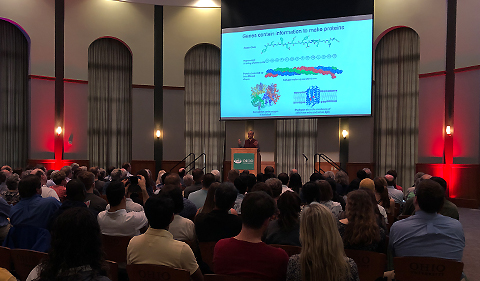
Dr. Venkatraman “Venki” Ramakrishnan during his public lecture at the Walter Hall Rotunda on May 2 (Photo: Jean Andrews/Ohio University)
By Amanda Biederman
NQPI editorial intern
Venkatraman “Venki” Ramakrishnan was 19 years old when he left his home in Baroda, India to join the Ohio University community in 1971. A first-year graduate student in physics, he had never dreamed that he would one day earn the Nobel Prize in Chemistry for his work on the structure of ribosomes.
“I was being a bit of a rebel; my parents were both biochemists,” Ramakrishnan joked, referring to his initial decision to pursue a degree in physics.
Just as ribosomes consist of the machinery necessary to translate genetic material into the proteins needed for life, Ramakrishnan skillfully translates his complex research into a form that conveys the beauty of cellular biology to a general audience. And like DNA itself, Ramakrishnan’s career trajectory has evolved over time, shifting from theoretical equations to experimental determinations of the ribosome structure.
Ramakrishnan recently returned to Athens to share his story with current students and faculty of Ohio University. As I sat among my peers during Ramakrishnan’s public lecture on May 2, I reflected on the relevance of his words for students today.
For scientists, a Ph.D. often represents the beginning of an academic career in a highly specialized field. Thus, it can be challenging to step out and appreciate the nature of our studies from a broader perspective. Ramakrishnan recounted that his decision to alter his career path was difficult; most universities were reluctant to take on a student who had already completed his doctoral training in a seemingly disparate field.

Amanda Biederman and Dr. Venkatraman “Venki” Ramakrishnan (Photo: Jean Andrews/Ohio University)
One of most striking aspects of Ramakrishnan’s story was his persistence. He spoke of the times that he faced rejection and resistance, and he recounted the methods he employed to overcome those challenges throughout his career.
When Ramakrishnan initially struggled to keep up with his peers in the first year of his biology graduate program at the University of California, San Diego, he pushed harder to master the material, even enrolling in undergraduate courses to broaden his understanding of biology. When he later resolved to join a highly competitive field of biological research, he sought creative strategies to compete with his well-funded colleagues.
“I had this long, interminable plane trip back (home after a scientific meeting with those colleagues), and I was just thinking of giving up the whole thing altogether,” Ramakrishnan said. ‘But then I thought, ‘This is the most important problem in this field and one of the most important problems in biology: how a gene is read to make proteins.’ And so I thought, ‘If I don’t do this and I watch other people do it, I would just be kicking myself. But if I tried and failed, that’s life.’”
Ramakrishnan’s story highlights the extraordinary value of an interdisciplinary career. As a trained physicist, Ramakrishnan was expected to pursue a career in theoretical computation. Yet his background in physics allowed him to pursue novel techniques as a biologist, ultimately leading him to the discovery that would help to revolutionize the world’s understanding of the mechanisms by which proteins are formed. Nearly five decades after he began his journey in Athens, Ohio, the lessons from Ramakrishnan’s story remain relevant to young scientists currently pondering their own career paths.
View Ramakrishnan’s public lecture, “The Quest for the Structure of the Biological Machine that Reads Our Genes.” See his memoir, The Gene Machine.
Amanda Biederman is a 5th-year Ph.D. candidate in the Department of Biological Sciences. She has worked as an editorial intern for the Nanoscale and Quantum Phenomena Institute since February 2016.



















Comments